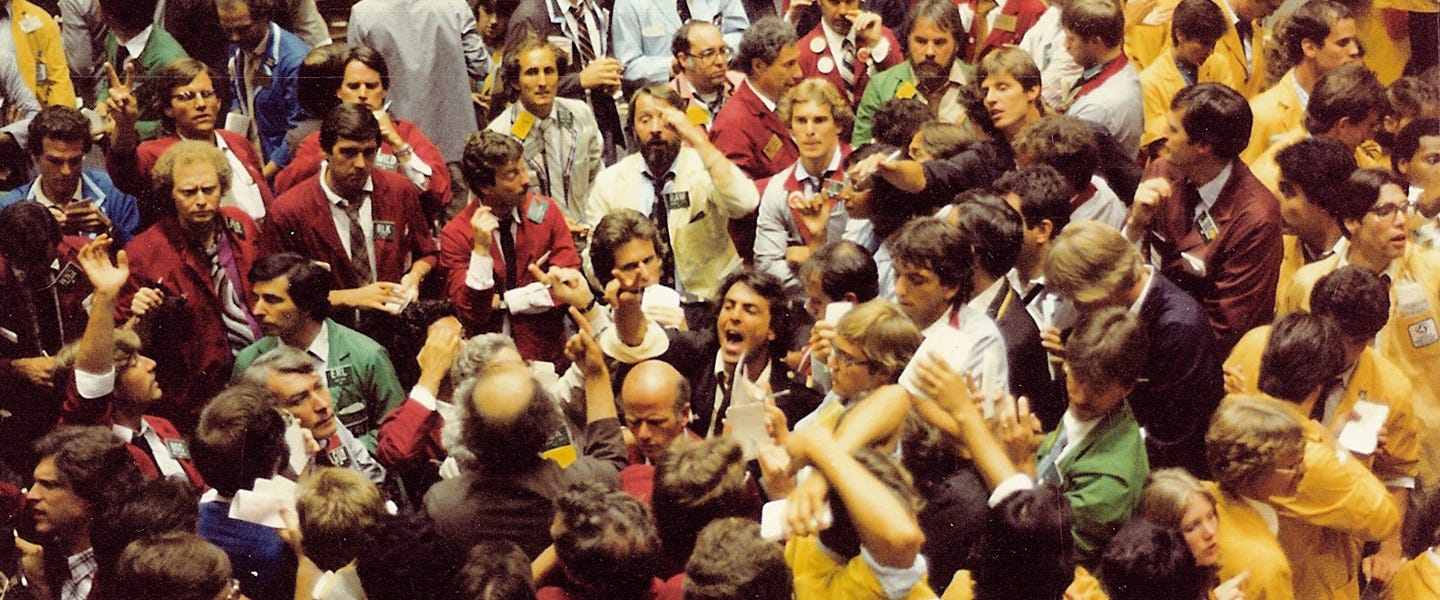From MEL Magazine at Medium:
An oral history about work life in Chicago’s notoriously high-stress, hard-partying commodity futures “pits”

This past July, the Chicago Mercantile Exchange (CME) (known more simply as “the Merc”) shuttered nearly all its trading pits after 167 years of operation. And with it died the pit trader — an infamously lucrative, stressful job characterized by ruthless competition, fraternal camaraderie and the frenzied screaming and hand signaling among men (and a few select women) exchanging billions of dollars worth of commodities per day.The pits dated back to 1848 when the Chicago Board of Trade (CBOT) established what would become the world’s first futures exchange. So-called “futures” contracts derived their name from their function — they were agreements between grain farmers and merchants to exchange a certain amount of grain at a future date for a particular price. Futures allowed grain farmers to know how much they could earn from their crops prior to harvesting, while merchants were able to lock in prices months in advance. Most importantly, it brought “price discovery” to the grain farming industry. Previously, grain farmers sold their crop yields independently and with little idea as to their actual value. The CBOT established a market rate for a bushel of grain, and a place where financial speculators could buy and sell futures contracts based on how they thought the price of grain — and later, other commodities — would fluctuate.The CBOT diversified into other agrarian markets throughout the 20th century — in 1936, it began trading soybeans, and in 1968 it added its first non-grain-related commodity: chickens. Meanwhile the CME — previously called the Chicago Butter and Egg Board until it changed its name in 1919 — dealt in frozen pork bellies and live cattle, and later foreign currencies such as Deutsch marks and Swiss francs.The 1980s saw the introduction of “options,” contracts derived of futures. Options differed from futures in that they were not as binding: A futures contract stipulated you were going to buy the commodity for the given price at the given date, whereas options were binding to only one party. The buyer would pay a small premium for the option on a contract, meaning he retained the sole right to buy the contract at the agreed-upon price over a given period of time. If the buyer thought it advantageous, he would “exercise his option” on the contract, and the seller was obligated to sell it to him. If the option wasn’t exercised by the end of designated time period, the contract expired and no money changed hands (although the contract holder kept the premium).Options drastically increased the complexity of the trading conducted on the floor and was the beginning of the end of a unique work culture (a trend exacerbated by automated trading).
Because unlike in New York, the financial epicenter of the world, the culture at the Merc and CBOT was decidedly blue collar. The prevailing image of a finance worker in the 1980s and 1990s was a WASP-y, East Coast Ivy leaguer from a prestigious family. Now it’s a computer science genius whose software executes thousands of trades in a fraction of a second. But many pit traders were from working class Irish, Italian and Jewish communities and were correspondingly hardscrabble.They hailed from the city’s South Side Irish-Catholic enclaves such as Beverly and Mount Greenwood; North Side Jewish neighborhoods (e.g. Northbrook, Highland Park); and bougie nearby suburbs (namely, Evanston and Oak Park). The ethnic-religious makeup of the pits was reflected in the names of the largest firms that traded there: Rosenthal & Co., Lee B. Stern & Co. and The Goldberg Association; Hennessy & Associates, O’Connor & Co. and Cunningham Commodities. The joke was that the CBOT was predominantly Irish- and Italian-Catholic while the CME attracted more Jewish workers.

They were drawn to the pit not just because it offered the opportunity to make hundred of thousands (if not millions) of dollars, but because one didn’t need a college degree to get a job and excel there. The pits were distinctly American in this way — simultaneously professional and crude; cutthroat and convivial; an insular meritocracy governed by both greed and interpersonal relationships.The death of the pit trader, then, is about more than the loss of a “work hard, play hard” culture, it’s emblematic of a troubling shift in the labor market at large: With jobs rapidly disappearing due to automation and a growing emphasis on computer programming skills, it’s increasingly difficult for high school (and many college) graduates to earn a middle class income....MORE